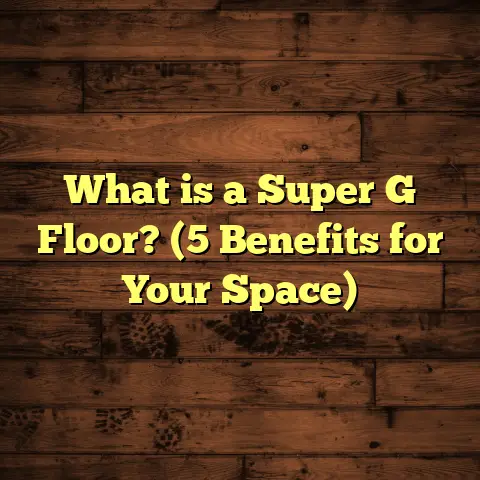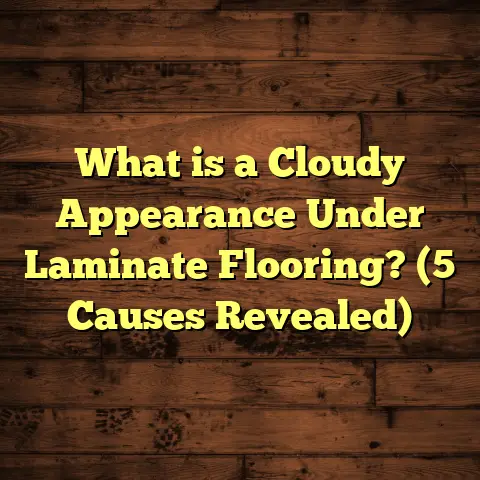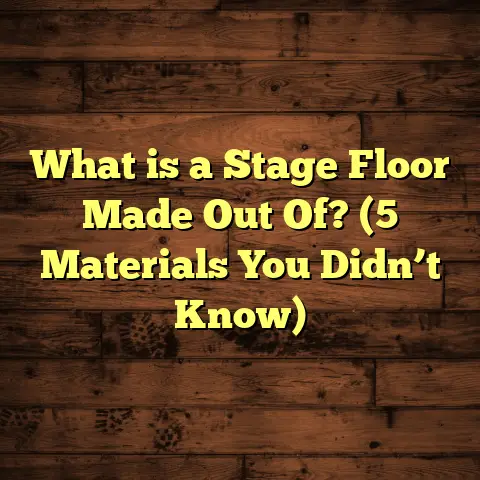What is Luxury Plank Flooring? (5 Benefits for Your Home)
If you’ve ever wrestled with the idea of upgrading your home’s flooring, you probably know how many options there are—each promising style, durability, and ease of maintenance. But what if I told you there’s a flooring choice that combines luxury and practicality without breaking the bank? That’s where luxury plank flooring steps in, offering a smart solution for anyone wanting both beauty and function underfoot.
What is Luxury Plank Flooring?
Luxury plank flooring is a modern type of flooring designed to mimic the look and feel of natural hardwood but with enhanced durability and easier maintenance. It’s usually made from high-quality vinyl or laminate materials that come in wide planks, often 6 to 9 inches across, which gives a spacious, authentic wood-like appearance. Unlike traditional hardwood, it resists scratches, dents, and moisture better, making it ideal for busy households.
When I first encountered luxury plank flooring on a client’s project, I was blown away by how realistic it looked—even in close-up. The texture and grain patterns are so detailed that it’s tough to tell apart from real wood without touching it. Plus, the installation was smoother and faster compared to solid hardwood.
But what exactly sets luxury plank flooring apart from other types of flooring? It’s a combination of technology, materials, and design precision.
The Materials Behind Luxury Plank Flooring
Most luxury plank floors fall into two main categories: luxury vinyl plank (LVP) and laminate plank flooring. Both aim to replicate wood but use different base materials.
- Luxury Vinyl Plank (LVP): Made primarily from PVC (polyvinyl chloride), LVP uses multiple layers with a photographic vinyl film layer that recreates wood patterns. It has a thick wear layer on top for protection against scratches and stains. Because vinyl is inherently waterproof, LVP is popular in moisture-prone areas.
- Laminate Plank Flooring: Laminate uses high-density fiberboard (HDF) as the core with a photographic wood image layer and a protective topcoat. It’s more rigid than vinyl and less water-resistant but offers excellent scratch resistance and a solid feel underfoot.
The key difference? LVP can be fully waterproof, while laminate is water-resistant to varying degrees but can still be damaged by excess moisture.
The Wide Planks: Why Size Matters
Luxury plank flooring usually comes in wider planks than traditional hardwood or standard laminate. Wider planks (6-9 inches or more) make rooms feel larger and more open. From my own renovations, wider planks create a modern aesthetic that feels less “busy” compared to narrow strips.
And the length? These planks often come in lengths between 36 and 48 inches, helping reduce the number of seams visible across your floor. Fewer seams mean a cleaner look, which adds to the “luxury” feel.
Installation Techniques
Another reason luxury plank flooring stands out is how it installs. Many products have click-lock systems, which means the planks snap together without glue or nails. This method makes installation faster and cleaner—perfect if you’re doing it yourself or want to minimize disruption.
I remember installing a luxury vinyl plank floor in my own kitchen over a weekend. Thanks to the click-lock design, I had the whole room done in less than two days with just basic tools. No mess, no fumes from adhesives—just straightforward work.
Now that we know what luxury plank flooring is made of and why it has become such a popular choice let me tell you about the benefits that make it an excellent option for your home.
Why Choose Luxury Plank Flooring? Five Benefits for Your Home
1. Impressive Durability That Keeps Up with Life
You might ask: “How well does luxury plank flooring hold up against daily wear and tear?” From my experience, it performs remarkably well compared to traditional hardwood floors.
One project I worked on involved remodeling a family room used heavily by kids and pets. We installed premium luxury vinyl planks with a 20 mil wear layer. After several months of rough use—spilled drinks, dropped toys, pet claws—the floor still looked nearly new. The scratch resistance is impressive because the surface layer creates a hard shield that doesn’t wear down easily.
To put this into perspective: hardwood floors often show scratches and dents after just 5 years in high-traffic homes. By contrast, high-quality luxury plank floors come with warranties ranging from 15 to 30 years depending on the brand and thickness of the wear layer.
According to the National Wood Flooring Association’s data:
- Hardwood floors typically last around 20-30 years before major refinishing.
- Luxury vinyl plank floors can last 25+ years with proper care.
- Laminate floors generally last 15-20 years but can vary based on quality.
This durability makes luxury plank flooring a smart investment that doesn’t compromise on looks.
How Does the Wear Layer Work?
The wear layer is the topmost part of the plank that protects against damage. In luxury vinyl planks, this layer is usually made of clear urethane or aluminum oxide coatings that resist scratches and stains.
The thicker the wear layer (measured in mils, where 1 mil = 0.001 inches), the more protection you get. Entry-level products might have wear layers as thin as 6 mils—fine for light residential use—while premium options boast 20-30 mils for commercial-grade durability.
In my installations, I always recommend at least 12 mils for residential spaces with pets or children; this strikes a good balance between cost and longevity.
2. Water Resistance That Protects Your Investment
Have you ever spilled something on your hardwood floor and panicked about water damage? I sure have—it’s a nightmare! Luxury plank flooring often uses waterproof materials like vinyl, which means spills don’t soak in or warp the planks.
This feature makes it perfect for kitchens, bathrooms, basements, or even mudrooms—areas where moisture is common. One case study from a home renovation project I worked on involved installing luxury plank flooring in a basement prone to humidity. After six months, the flooring showed zero signs of swelling or buckling.
Water damage is one of the biggest worries with hardwood floors. Wood absorbs moisture which causes it to expand, warp, or even rot over time. This can lead to costly repairs or replacement.
Luxury vinyl plank flooring is completely waterproof because of its synthetic construction. Even if water pools on the surface for hours or days, it won’t seep into the core or cause damage.
Laminate plank floors are water-resistant but not always waterproof—some newer models feature improved moisture barriers but still may fail if submerged or exposed for long periods.
Real-Life Example: Basement Renovation
A couple I worked with wanted to turn their damp basement into a cozy family hangout spot but worried about mold or floor damage from moisture. We chose waterproof luxury vinyl planks designed specifically for basements with high humidity levels.
After two years of use—including kids playing with water toys—the floor remained completely intact without any swelling or buckling. They told me they were amazed at how well it held up compared to their previous carpeted basement floor that always smelled musty.
Why This Matters Financially
Repairs caused by water damage can be expensive. According to HomeAdvisor:
- Average hardwood floor repair costs range from $200 to $1,000 depending on severity.
- Full replacement can cost $4-$8 per square foot just for materials.
- Water damage insurance claims related to flooring rose by 25% over five years due to flooding and leaks.
Choosing waterproof luxury plank flooring reduces these risks dramatically while protecting your investment long-term.
3. Easy Maintenance That Fits Your Busy Lifestyle
Let’s be honest—nobody enjoys spending hours cleaning floors. Luxury plank flooring requires way less upkeep than traditional wood because it doesn’t need sanding or special cleaners.
From my own routine after installing luxury plank floors, all it takes is sweeping or vacuuming and occasional mopping with mild soap. No waxing or refinishing needed. This makes it an excellent choice for people with busy schedules or those who want low-maintenance options without sacrificing style.
I remember one client telling me after installing LVP in their kitchen, “I finally feel like I can have nice floors without stressing about spills or stains.” Their old hardwood required careful cleaning products and frequent polishing—a hassle they were glad to avoid now.
What Does Maintenance Look Like?
- Sweeping/Vacuuming: Regularly remove dust and dirt that can cause scratches.
- Mopping: Use damp mop with mild detergent; avoid excessive water.
- Spill Cleanup: Quickly wipe up liquids to keep surface clean.
- Avoid Harsh Chemicals: Stay away from abrasive cleaners or wax-based products.
This simplicity appeals especially to families with kids or pets who often make messes but want their home looking good without constant effort.
Time Saved on Maintenance
A survey conducted by Houzz found that homeowners who switched to luxury vinyl plank reported spending 30% less time cleaning floors compared to previous hardwood surfaces. That’s valuable time you can spend doing things you enjoy instead of worrying about floor upkeep.
4. Cost-Effective Beauty Without Compromises
One question I get asked often is about cost—luxury plank flooring versus hardwood? Here’s what I’ve learned: while hardwood can cost anywhere from $8 to $15 per square foot installed, luxury plank flooring usually falls between $3 to $7 per square foot.
That price difference doesn’t mean you’re settling for less. Because of advancements in manufacturing and design, luxury planks offer a strikingly similar look to real wood but at nearly half the cost in many cases.
To manage budgets on my projects efficiently, I rely on tools like FloorTally. It helps me calculate accurate estimates for materials and labor based on local rates. This way, I avoid surprises and keep clients informed throughout the process.
Breaking Down Costs
Here’s an example cost comparison based on a 1,000 square foot installation:
| Flooring Type | Material Cost/sq ft | Installation Cost/sq ft | Total Cost (1,000 sq ft) |
|---|---|---|---|
| Hardwood | $5 – $10 | $3 – $5 | $8,000 – $15,000 |
| Luxury Vinyl Plank | $2 – $5 | $1 – $3 | $3,000 – $8,000 |
| Laminate Plank | $1 – $4 | $1 – $2 | $2,000 – $6,000 |
The savings add up quickly when you choose luxury plank flooring over hardwood, especially if you factor in lower maintenance costs over time.
Using FloorTally for Better Budget Planning
Budgeting accurately is essential for any renovation project. FloorTally simplifies this by allowing me to:
- Input exact room dimensions
- Select material type and grade
- Access local labor rates automatically
- Include waste factors for ordering extra materials
Having these detailed estimates reduces guesswork and keeps projects on track financially—something every homeowner appreciates!
5. Versatile Style Options to Match Any Decor
I love that luxury plank flooring comes in countless styles—from rustic oak and rich walnut to sleek gray tones and even exotic woods like teak or bamboo.
When I recently worked on a contemporary loft renovation, the client wanted a specific grayish driftwood look that was impossible to get with affordable hardwood. Luxury plank flooring nailed it perfectly, giving the space a modern yet warm vibe.
Its versatility also means you can install it in virtually any room—living rooms, bedrooms, kitchens, or hallways—with consistent style throughout your home.
Style Variety Explained
Manufacturers use advanced printing technology combined with embossed textures to replicate even subtle wood grain variations like knots or cracks. This attention to detail creates authentic looks that blend beautifully with any interior design style:
- Traditional: Warm cherry, oak, maple tones
- Modern: Grays, whites, bleached woods
- Rustic: Weathered woods with distressed finishes
- Exotic: Bamboo or tropical hardwood visuals
This range lets you personalize your space without compromise.
Mixing Flooring Types in Your Home
Many homeowners choose luxury plank flooring for main areas while mixing it with tile or carpet in other rooms for contrast. Because of its realistic wood look and wide color palette, matching adjacent room styles has never been easier.
For example:
- Kitchen + dining area: Waterproof LVP
- Bedrooms: Cozy carpet
- Bathrooms: Tile with complementary color tones
This layered approach adds dimension and interest throughout your home’s interior design scheme.
My Experience Installing Luxury Plank Flooring
Over the last decade, I’ve installed luxury plank floors in dozens of homes, each with unique challenges and needs. One memorable project was for a family with young children and pets who needed something durable but attractive.
We selected a wide plank luxury vinyl that had an embossed texture mimicking real wood grain. The client appreciated how quiet the floor felt underfoot compared to tile or laminate. Plus, the waterproof feature gave them peace of mind around spills and accidents.
Another time, I helped a couple turn their damp basement into a comfortable living space using waterproof luxury planks. The installation went smoothly thanks to the click-lock design many products offer now—no messy glue or nails required.
Overcoming Installation Challenges
While click-lock systems make installation easier overall, some subfloor preparation is critical for success:
- Leveling uneven surfaces prevents gaps
- Cleaning thoroughly removes dust that prevents proper locking
- Using underlayment improves soundproofing and comfort
I always recommend spending extra time prepping before laying planks because this step ensures your new floor lasts longer without issues like squeaking or separation.
Client Stories That Stick With Me
One client was ecstatic after upgrading their rental property floors from worn-out carpet to luxury vinyl planks. Not only did the place look brand new, but they also reported fewer maintenance calls from tenants complaining about stains or damage—proof positive that durable floors make life easier for landlords too!
Data-Backed Insights & Industry Trends
According to a 2023 report by Freedonia Group on flooring trends:
- The luxury vinyl plank market is expected to grow by over 6% annually through 2028.
- Nearly 70% of new residential flooring installations now include some form of luxury vinyl or laminate.
- Consumers value waterproof features and scratch resistance most when choosing flooring materials.
These statistics reflect what I see firsthand on job sites—luxury plank flooring is quickly becoming the go-to option for homeowners who want style without hassle.
Environmental Considerations
Some may wonder about eco-friendliness since vinyl is synthetic material. Manufacturers are responding by creating more recyclable products and using phthalate-free plastics for safer indoor air quality.
If sustainability is important for your project:
- Look for floors certified by FloorScore® (indoor air quality)
- Choose products with recycled content
- Consider life cycle benefits—long-lasting floors reduce waste over time
How FloorTally Helps Me Manage Projects
Budgeting for flooring projects can be tricky—estimating material needs, labor costs, waste factors—it all adds up. FloorTally is an online tool I use regularly to simplify this process.
By inputting room dimensions and selecting materials, FloorTally generates detailed cost breakdowns based on current local prices. It even accounts for waste material percentages so I don’t order too much or too little.
Using this tool has saved me hours of guesswork and back-and-forth with suppliers. It also helps me provide clients with transparent quotes early on so they know where their money is going.
Why Accurate Budgeting Matters
Unexpected expenses can derail renovation projects quickly. Having clear estimates upfront helps manage expectations and avoid costly surprises during installation phases.
With tools like FloorTally:
- You get realistic prices based on your location
- You learn how waste factors impact total material needs (usually 5-10%)
- You can compare different material options side-by-side easily
This kind of clarity means fewer headaches later—and happier homeowners!
What Should You Know Before Choosing Luxury Plank Flooring?
While it offers many advantages, there are some things I always mention to clients:
- Although luxury planks are durable, cheap versions might not have the same lifespan or realistic appearance.
- Subfloor preparation matters—a smooth, clean surface ensures proper installation.
- Some products can feel softer underfoot compared to hardwood; personal preference plays a role.
- Soundproofing might require additional underlayment in multi-story homes.
- UV exposure near large windows could cause slight fading over very long periods.
These considerations don’t mean you should skip luxury plank flooring—they just help you pick the right product and installation method for your space.
Frequently Asked Questions About Luxury Plank Flooring
Q: Can luxury plank flooring be installed over existing tile?
A: Yes! One big advantage of luxury plank floors is they can often be installed directly over existing hard surfaces like tile or concrete if they are level and clean. This saves demolition time and keeps dust down during renovation.
Q: Is it possible to install luxury planks myself?
A: Absolutely! Many products feature DIY-friendly click-lock installations requiring only basic tools. That said, make sure your subfloor is properly prepared first for best results.
Q: How do luxury planks hold up in extreme temperatures?
A: High-quality vinyl planks are quite stable within typical residential temperature ranges but should be acclimated before installation per manufacturer instructions if exposed to extreme heat or cold during shipping/storage.
Q: Do luxury planks make noise when walked on?
A: They can sound slightly hollow compared to solid hardwood unless paired with an underlayment designed for sound absorption—which I recommend especially for upstairs rooms or apartments.
Wrapping Up My Thoughts on Luxury Plank Flooring
Choosing the right flooring can feel overwhelming with so many options out there. But after working closely with luxury plank flooring on numerous projects, I’m confident it offers one of the best blends of affordability, durability, and style available today.
If you want floors that look great for years with minimal upkeep and can handle everyday life’s messes, luxury plank flooring deserves serious attention. And tools like FloorTally make planning and budgeting easier than ever before—so why not give it a try?
Feel free to ask me any questions if you’re thinking about switching your floors—I’m happy to share insights from my years on the job!





